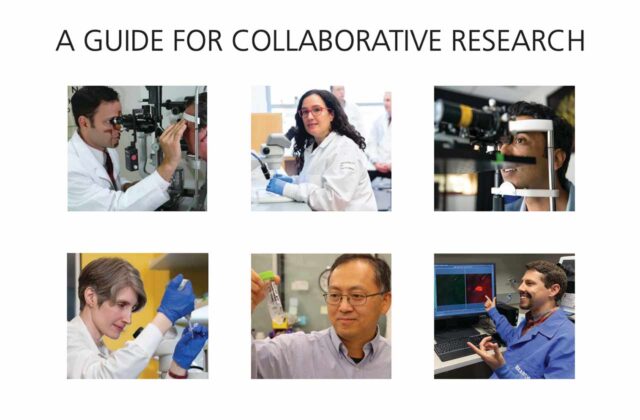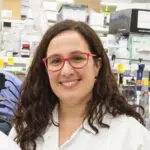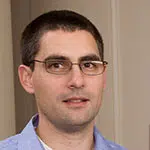Catalyst for a Cure
Catalyst for a Cure is Glaucoma Research Foundation’s flagship research program. Groundbreaking, collaborative, committed to results — this unique discovery model brings great minds together to deliver a future free from glaucoma.
Video: Glaucoma Research Progress
The Catalyst for a Cure initiative brings together neuroscientists and glaucoma specialists to study glaucoma, find better treatments, and accelerate progress toward vision restoration and a cure.
Catalyst for a Cure grows from two research realities: Discovery happens faster when talented scientists work together. And breakthroughs don’t occur unless people invest in them.
Driven by our mission to catalyze a quantum leap in glaucoma care, Glaucoma Research Foundation engages scientists and philanthropists in a unique proposition: With support from donors who share our quest for a cure, our team of advisors selects four top researchers from four leading institutions to form a consortium dedicated to eradicating glaucoma. Investigators partner for three years, generating discoveries future teams can build on. Based on progress, the Foundation board may vote to extend a consortium’s funding for three additional years.
Launched in 2002, the first team of investigators (CFC1) changed the conventional understanding of glaucoma as an eye disease to a new understanding of glaucoma as a neurodegenerative disease, revealing the possibility of new therapeutic approaches. From 2012 to 2018, the second Catalyst for a Cure (CFC2), the Biomarker Initiative, identified novel indicators of disease, enabling clinicians to detect, measure, and treat glaucoma with unprecedented precision.
In 2019, in partnership with generous supporters, we launched CFC3, the Catalyst for a Cure Vision Restoration Initiative. Leveraging discoveries from the first two CFC teams, four investigators are speeding the quest to restore vision lost to glaucoma. Early results have been extremely promising, leading the way for new genetic, neuroprotective, and cell replacement therapies and bringing us ever closer to a cure.
A fourth initiative launched in 2022 is investigating what glaucoma has in common with other neurodegenerative conditions, such as Alzheimer’s disease, Parkinson’s, and amyotrophic lateral sclerosis (ALS). The Melza M. and Frank Theodore Barr Foundation Catalyst for a Cure Initiative to Prevent and Cure Neurodegeneration breaks new ground by supporting research into multiple diseases, seeking knowledge and solutions that could affect all neurodegenerative conditions.
The Catalyst for a Cure discovery model is unique in the world of scientific research. Usually, scientists work individually and often compete for grant money. In contrast, Catalyst for a Cure investigators, working out of their own labs at prestigious academic centers across the country, pursue promising leads together. They design their research in partnership, report results as a team, and, learning from and inspiring each other, generate insights much more quickly than they could working alone. Through their generous donations, supporters of Glaucoma Research Foundation make this unique and important progress possible.
Explore Catalyst for a Cure Initiatives
CFC4: The Melza M. and Frank Theodore Barr Foundation Catalyst for a Cure Initiative to Prevent and Cure Neurodegeneration
Launched in July 2022, the fourth in Glaucoma Research Foundation’s Catalyst for a Cure series pursues one of our most confounding medical challenges: how to prevent and cure diseases that, like glaucoma, Alzheimer’s, Parkinson’s, and amyotrophic lateral sclerosis (ALS), occur when key cells in the central nervous system deteriorate and die — a process known as neurodegeneration.
CFC4 advances a transformative discovery by the first Catalyst for a Cure team: that glaucoma, long considered a disease of the eye, is actually a neurodegenerative illness. Although neurodegenerative illnesses are increasing in prevalence, treatments that protect, repair, or regenerate neurons remain elusive. By bringing together innovative investigators whose paths would not otherwise cross, the CFC model provides unique potential for outside-the-box scientific creativity — the kind of high-risk/high-reward research that rarely wins support from traditional funders.
STATUS
Initiated in 2022. Currently funded through 2027.
GOALS
Explore similarities and differences among glaucoma and other conditions that stem from the death of neurons in the eye, brain, or spinal cord, in search of potential preventive measures and cures for all neurodegenerative illnesses.
INVESTIGATORS

Sandro Da Mesquita, PhD
Assistant Professor, Department of Neuroscience
Meningeal Lymphatics and Neurological Disorders Lab
Mayo Clinic
Dr. Da Mesquita’s unique expertise is in the field of brain vascular biology, which has implications for Alzheimer’s and other neurodegenerative diseases.

Milica Margeta, MD, PhD
Physician and Surgeon
Massachusetts Eye and Ear
Assistant Professor of Ophthalmology
Harvard Medical School
Dr. Margeta is a glaucoma clinician and surgeon and a leader in the biology of microglia (unique cells of the brain and spinal cord) and in neuroinflammation.

Karthik Shekhar, PhD
Assistant Professor, Department of Chemical and Biomolecular Engineering
Faculty Scientist, Lawrence Berkeley Laboratory
Member, Helen Wills Neuroscience Institute
University of California Berkeley
A leader in computational biology, Dr. Shekhar has played a key role in collaborations that span neuroscience, immunology, single cell genomics, genetics, and machine learning, with a focus on visual systems.

Humsa Venkatesh, PhD
Assistant Professor, Program in Neuroscience
Brigham and Women’s Hospital
Harvard Medical School
Dr. Venkatesh’s discoveries have shaped the emerging field of cancer neuroscience, illuminating the nervous system’s role in disease progression.
RESULTS
The CFC4 investigators in the Neurodegeneration Initiative have been testing specific tissues to compare between Alzheimer’s disease, glaucoma, and gliomas. Using bioinformatics techniques, they analyzed existing genetic data and their initial experimental data. Their results suggest several potential common targets for new treatments. The team plans to continue their analysis of tissue from normal and disease models and from patients with these diseases. Their goal is to discover common molecular and cellular pathways across the three diseases of the central nervous system that could be used to advance diagnosis and treatment of these blinding and fatal diseases.

Read “Catalyst for a Cure Report: Twenty Years of Innovation 2002 to 2022 — A Guide for Collaborative Research.”











